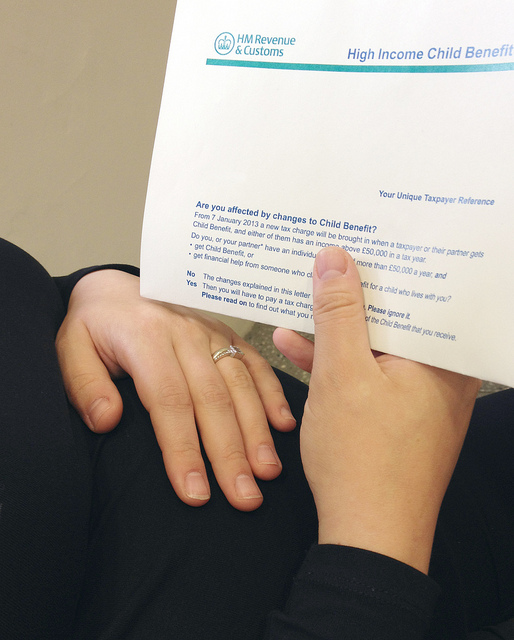
In her first guest post of 2015, Standard Life family finance expert Julie Hutchison tackles the thorrny issue of child benefit. In this post, Julie not only succinctly explains how the system works, but also outlines how you can retain your child benefit by increasing your pension contributions.
In early January while you were recovering from New Year excesses, you might not have noticed a twitter exchange was underway on @dadbloguk. @Andy_CV had some questions about the tax charge which can apply if you receive child benefit. The 140 character limit soon led me to throw in the towel and offer to write my next guest blog on the topic, so here it is. @Andy_CV I hope this answers your question!

If you’re a parent, you’ll know that child benefit gives you a bit of financial help. It’s £20.50 a week and then £13.55 per additional child. One child families are the most common type, according to official figures, so this equates to £1,066 a year if that’s you, or around £1,770 with two children.
Child benefit is paid tax free, although you may be one of the million or so families affected who have to pay a ‘High Income Child Benefit Charge’, if you or your partner’s income is over £50,000. It’s not your combined income which counts – it’s your individual incomes which are tested.
If your income is over £50,000, the tax charge will cancel out some of the value of child benefit. And once you have income of £60,000 or more, the tax charge will clawback the whole value of child benefit.
The maths for how to work out the tax charge are helpfully set out in an example on the Citizen’s Advice Bureau website (note that it uses previous year figures, but the method is the same). The shorthand way to look at it is this: for each £1,000 of income over £50,000, you lose 10% of your child benefit as a tax charge. Income of £51,000 means you pay a 10% charge on your child benefit. Income of £55,000 means you pay a 50% charge on your child benefit. Income of £57,000 means you pay a 70% charge on your child benefit, and so on, until you reach £60,000 when the tax charge matches the child benefit paid.
So, how does paying into a pension help to restore the value of child benefit and remove some or all of the tax charge? It’s because some types of payment into a pension reduce the income figure used to test whether you face a tax charge. The taxman has a particular definition of ‘income’.
Let’s look at an example, where Jane is a freelance consultant with income of £52,000 (before tax).
She has one child and her partner has a part-time job, with income below the £50,000 threshold. She would receive child benefit of £1,066 but pay a tax charge of £213 on this (£1,066 x 20%).
Alternatively, if Jane paid £1,600 into a pension, it gets a tax relief top-up of 20%, which means £1,600 becomes £2,000 in her pension. The pension contribution plus the 20% pension tax relief is deducted from ‘income’ used to test whether Jane will have to pay a tax charge on her child benefit. Jane’s income of £52,000 has been reduced to £50,000 because of her pension payment, which means she will be able to keep all of her child benefit.
Jane would need to complete a tax return to claim her additional tax relief as a higher rate taxpayer and also to stop the tax charge applying to the child benefit.
However, if Jane was employed (rather than self-employed) and had a workplace pension, she may not need to complete a tax return since it’s possible that her pension payment would come from her gross (pre-tax) salary. Many workplace schemes pay pension contributions before tax has been deducted. This means her ‘income’ has already been adjusted for tax purposes. Her P60 showing her ‘income’ for the year would already be correct since it would show her salary minus her pension payment.
In @Andy_CV’s case, since his pension payment came from gross (pre-tax) and not net (post-tax) salary, his income would not need further adjustment and his P60 would show the correct income figure for the year, to be tested against the £50,000 threshold.
This would be different for someone who is self-employed or anyone who has made contributions to their pension out of their taxed income. If you’re in that position, you need to adjust your income figure to take account of the pension payments you have made (remembering the tax relief top-up is a deduction too).
Although you can request that child benefit payments are not made, so that the tax charge is stopped, it’s not usually recommended that you do this. It would have a negative impact on a non-working partner. That’s because, if child benefit is claimed for a child under 12, there’s an additional year’s National Insurance credit. This counts towards the 35 years needed to claim the full State Pension from 2016.
For more information about the tax charge with child benefit, visit the government website which has a child benefit tax calculator. Should you have any requests for future topics for blogs, please leave a comment below.
Julie is a regular blogger at the Moneyplus blog.
A pension is an investment. Its value can go up or down and it may be worth less than you paid in. This blog and any responses are not financial advice. Making additional payments into a pension may not suit your circumstances – speak to an expert for information about your situation.
This post is published in association with Standard Life. For more information on collaborative blog posts, please see my Disclosure page. Pic credit: HMRC. Reproduced under Creative Commons agreement 3.0. For further information about Creative Commons and for links to the various agreements, follow the link to my Disclosure page (see above).







6 thoughts on “How to keep your child benefit by paying into a pension”
Really informative post John, I had no idea that paying more into your pension could offset the tax for child benefit! There are so many ways around situations like this, and now I know where to come when I want to find them out…
It was news to me as well Renee. If there are any particular financial issues you would like more information about, please do let me know. Julie writes a monthly guest post and she is happy to consider any such ideas.
Great info! Do cash benefits such as a car allowance get included in the calculation?
Yes, I think they do Gary – it’s your total income which counts – the figure on your P60 is a relevant one to look at.
kind regards
Julie
Can I just check that the following also applies to higher rate tax? i.e. if I have a pretax income of £42000 and am due to be paid a £2000 bonus, normally I would pay the bonus at 40% rate of tax. If I had paid £4000 into a pension in the year before the bonus, would I now just pay the basic rate of tax on the bonus?
Hi Mike
Yes, i think the end result is similar – paying £4,000 into your pension from your net income becomes £5,000 with the tax relief top-up. And your basic rate band (where you pay tax at 20%) is expanded by £5,000, which covers your bonus.
kind regards
Julie